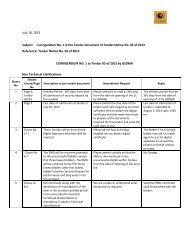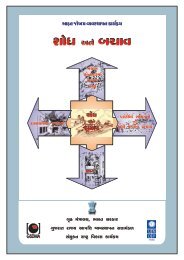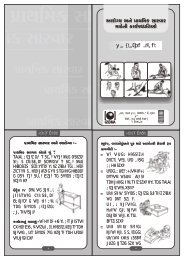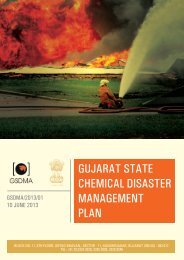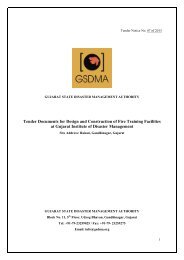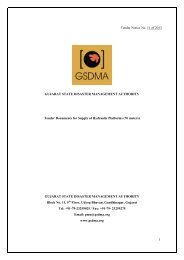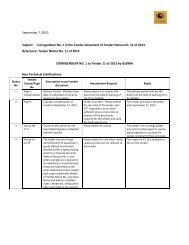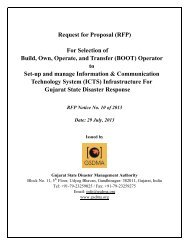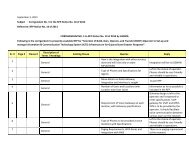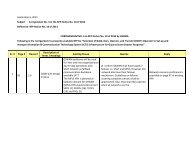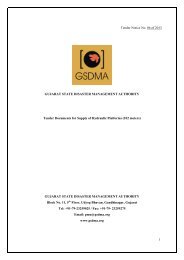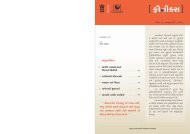Emergency Response Guidebook - Gujarat State Disaster ...
Emergency Response Guidebook - Gujarat State Disaster ...
Emergency Response Guidebook - Gujarat State Disaster ...
Create successful ePaper yourself
Turn your PDF publications into a flip-book with our unique Google optimized e-Paper software.
GUIDE163Radioactive Materials(Low to High Level Radiation)ERG2012ERG2012Radioactive Materials(Low to High Level Radiation)GUIDE163POTENTIAL HAZARDSHEALTH• Radiation presents minimal risk to transport workers, emergency response personnel and the publicduring transportation accidents. Packaging durability increases as potential hazard of radioactivecontent increases.• Undamaged packages are safe. Contents of damaged packages may cause higher external radiationexposure, or both external and internal radiation exposure if contents are released.• Type A packages (cartons, boxes, drums, articles, etc.) identified as “Type A” by marking on packagesor by shipping papers contain non-life endangering amounts. Partial releases might be expected if“Type A” packages are damaged in moderately severe accidents.• Type B packages, and the rarely occurring Type C packages, (large and small, usually metal) containthe most hazardous amounts. They can be identified by package markings or by shipping papers. Lifethreatening conditions may exist only if contents are released or package shielding fails. Because ofdesign, evaluation and testing of packages, these conditions would be expected only for accidents ofutmost severity.• The rarely occurring "Special Arrangement" shipments may be of Type A, Type B or Type C packages.Package type will be marked on packages, and shipment details will be on shipping papers.• Radioactive White-I labels indicate radiation levels outside single, isolated, undamaged packages arevery low (less than 0.005 mSv/h (0.5 mrem/h)).• Radioactive Yellow-II and Yellow-III labeled packages have higher radiation levels. The transport index(TI) on the label identifies the maximum radiation level in mrem/h one meter from a single, isolated,undamaged package.• Some radioactive materials cannot be detected by commonly available instruments.• Water from cargo fire control may cause pollution.FIRE OR EXPLOSION• Some of these materials may burn, but most do not ignite readily.• Radioactivity does not change flammability or other properties of materials.• Type B packages are designed and evaluated to withstand total engulfment in flames at temperaturesof 800°C (1475°F) for a period of 30 minutes.PUBLIC SAFETY• CALL EMERGENCY RESPONSE Telephone Number on Shipping Paper first. If Shipping Paper notavailable or no answer, refer to appropriate telephone number listed on the inside back cover.• Priorities for rescue, life-saving, first aid, fire control and other hazards are higher than the priority formeasuring radiation levels.• Radiation Authority must be notified of accident conditions. Radiation Authority is usually responsiblefor decisions about radiological consequences and closure of emergencies.• As an immediate precautionary measure, isolate spill or leak area for at least 25 meters (75 feet) in alldirections. • Stay upwind. • Keep unauthorized personnel away.• Detain or isolate uninjured persons or equipment suspected to be contaminated; delaydecontamination and cleanup until instructions are received from Radiation Authority.PROTECTIVE CLOTHING• Positive pressure self-contained breathing apparatus (SCBA) and structural firefighters’ protectiveclothing will provide adequate protection against internal radiation exposure, but not externalradiation exposure.EVACUATIONLarge Spill• Consider initial downwind evacuation for at least 100 meters (330 feet).Fire• When a large quantity of this material is involved in a major fire, consider an initial evacuationdistance of 300 meters (1000 feet) in all directions.Page 266EMERGENCY RESPONSEFIRE• Presence of radioactive material will not influence the fire control processes and should not influenceselection of techniques.• Move containers from fire area if you can do it without risk.• Do not move damaged packages; move undamaged packages out of fire zone.Small Fire• Dry chemical, CO 2, water spray or regular foam.Large Fire• Water spray, fog (flooding amounts).• Dike fire-control water for later disposal.SPILL OR LEAK• Do not touch damaged packages or spilled material.• Damp surfaces on undamaged or slightly damaged packages are seldom an indication of packagingfailure. Most packaging for liquid content have inner containers and/or inner absorbent materials.• Cover liquid spill with sand, earth or other non-combustible absorbent material.FIRST AID• Call 108 or emergency medical service.• Medical problems take priority over radiological concerns.• Use first aid treatment according to the nature of the injury.• Do not delay care and transport of a seriously injured person.• Give artificial respiration if victim is not breathing.• Administer oxygen if breathing is difficult.• In case of contact with substance, immediately flush skin or eyes with running water for at least 20minutes.• Injured persons contaminated by contact with released material are not a serious hazard to healthcare personnel, equipment or facilities.• Ensure that medical personnel are aware of the material(s) involved, take precautions to protectthemselves and prevent spread of contamination.Page 267



